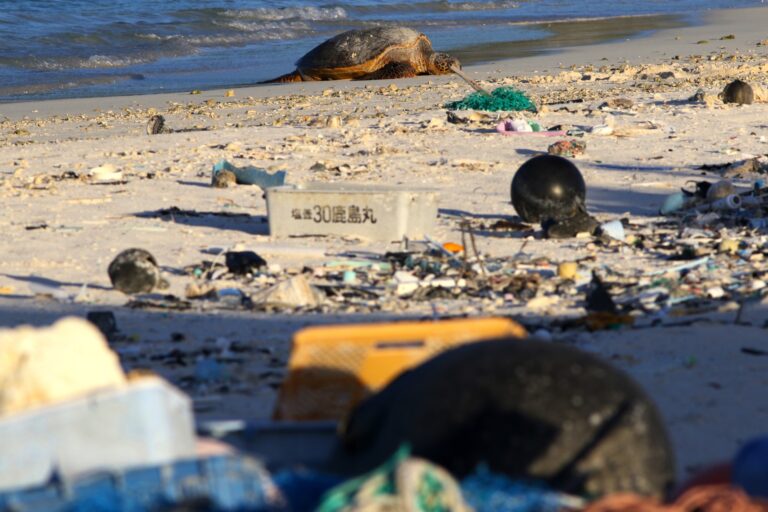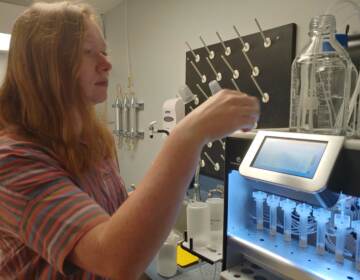How research labs contribute to the pollution problem
Single use plastic and energy-hogging equipment are among the culprits. Some scientists are trying to find a better way.
Listen 7:28
A green sea turtle rests on the beach among marine debris on Midway Atoll in the Northwestern Hawaiian Islands. In one of the most remote places on Earth, Midway Atoll is a wildlife sanctuary that should be a safe haven for seabirds and other marine animals. (AP Photo/Caleb Jones)
This story is from The Pulse, a weekly health and science podcast.
Subscribe on Apple Podcasts, Stitcher or wherever you get your podcasts.
It took a long time for Stephanie Borrelle to believe the results of her own research.
“I can’t even tell you how many times I ran that model and checked the data,” she said. “I just couldn’t fathom that it was reality.”
Borrelle is an ecologist and plastic pollution researcher at the University of Toronto, who, until recently, spent much of her time traversing island shores studying seabirds and all the trash inside them.
“I would collect birds from the beaches as they were blown in from storms. And when we dissected them, they were full of plastic,” Borelle said.
She wasn’t particularly surprised by that. Researchers first observed the ingestion of plastic by marine animals all the way back in the 1960s, and plastic production and pollution has only grown since.
But Borrelle was astounded by the sheer amount of plastic the birds had eaten and wanted to know the full extent of the problem: How much plastic pollution is actually in our waters? And, with decades of research now behind us, is the global community doing enough to curb marine plastic pollution for the future?
Borrelle and a team of researchers decided to crunch the numbers. They created a model that factored in current waste management trends, population growth, regional income levels, and recent governmental initiatives to phase out plastic production and reduce waste. The team would consider any possible outcome under the target limit of 8 million metric tons per year, the estimated amount of marine plastic pollution from 2010, as environmentally acceptable.
As Borrelle would learn, such an outcome was barely imaginable. The study showed that by the end of this year alone a grim 24 million to 35 million metric tons of plastic will likely find its way into our waters. And if nothing changes by 2030, that number could jump to nearly 90 million metric tons per year.
“I don’t even know how to give you an analogy that can make it easier to comprehend. It is just an enormous amount of plastic,” Borrelle said.
In the face of such a seemingly insurmountable problem, she dreaded using plastic in her everyday life.
“It’s kind of unavoidable. I felt really guilty about it,” Borrelle said.
She thought about her time on the beach gathering birds rotting around the plastic bric-a-brac inside their bellies, and how even just researching pollution created more pollution.
“I was collecting samples from islands and having to store them into small plastic containers. And I did my best to sort of reuse them as many times as possible, but there’s only so much you can do,” she said. “It was just kind of awful.”
The problem for Borrelle, and other scientists concerned about how their work affects the environment, is that the same physical properties that make plastic so harmful to marine life also make it extremely useful for conducting scientific research.
Plastic is quite literally a shapeshifter. It can be made rigid or flexible, formed into a mold, microwaved and frozen. And survive it all with minimal degradation.
More importantly, it’s also cheap — which makes it disposable.
“Everything’s like single use, single use, single use in labs,” said Eli Preston, the manager of a developmental genetics laboratory at the University of Pennsylvania. “You want it to be sterile, and you want to save time.”
That means it’s usually easier, faster and more cost-effective to break out a brand new plastic pipette than clean one that’s dirty. It wasn’t long before Preston became frustrated by all the plastic trash piling up.
“I just wanted to cut down on the huge amounts of waste that our lab produces,” they said.
So Preston set out to convince researchers at the university to make a change. They received a grant to purchase reusable glass petri dishes for their lab and produced a video showing exactly how to clean them, hoping to encourage others to invest, too.
Subscribe to The Pulse
But while the initiative garnered attention from fellow researchers around the world, other labs at the University of Pennsylvania have yet to make the switch.
“I feel like scientists can be really focused,” said Preston. “Science is hard, and they don’t want things that might slow them down or just be a change that they don’t know about.”
Though some changes take time to catch on, others take only a little friendly competition.
Kathyrn Ramirez-Aguilar manages the Green Labs Program at the University of Colorado Boulder. She started thinking about science’s sustainability problem over a decade ago and was surprised to find that sustainability just wasn’t on many researchers’ radar.
“At most, there were stickers on the light switches asking us to turn off the lights,” she said.
She quickly discovered that research labs are huge energy hogs, even with all the lights off. The real big, humming elephants in the room are all those high-tech freezers scientists use to store their samples. The average ultra-low temperature freezer can use as much energy in one year as a single U.S. home. They are always on, and they are always very, very cold.
So Ramirez-Aguilar and her colleagues at the International Institute for Sustainable Laboratories created the Freezer Challenge, a contest that asks participating researchers to tune, clean, and divvy up their freezers whenever possible, and report back all the details to earn points.
“We wanted to create a competition, and we wanted to have competition between our institutions,” Ramirez-Aguilar said.
Over the past four years, the Freezer Challenge has grown from over 38 participating institutions to 88. So far, the competition has saved enough energy to offset the carbon emissions equivalent of driving a car over 15 million miles. That’s about eight years’ worth of NASCAR, erased.
Ramirez-Aguilar does not want to stop there. She believes that science must become greener, and that it will take more than just competition to do it. Among large-scale environmentally minded integrations and equipment-sharing programs, she points to recent efforts in the United Kingdom to link sustainability standards and expectations to scientific funding as a promising model for the future.
For now, at least the freezer manufacturers are taking notice.
“The market for freezers, especially ultra-low temperature freezers has shifted so quickly, because the pressure is rising to do that on those industries,” Ramirez-Aguilar said. “It really is a demonstration, in my opinion, that when that pressure is there to produce more energy or water efficient equipment options for the scientists to purchase, that the industry can change. I was impressed at how rapid it was.”
For a while, plastic pollution researcher Stephanie Borrelle hoped that the market would shift to reduce plastic waste, too. That armed with research like hers, global leaders and policymakers might recognize the rising tide of pollution, and all the birds full of garbage, and turn course. But she’s moved on from hope.
“I think about hope as being a very passive word. It implies that someone else is going to come and fix the problem – that we don’t have to do anything else. Whereas I sort of feel like when I’ve lost all hope, it’s actually now manifested as determination. And determination to me reflects action,” she said.
For Borrelle, that means continuing her efforts to quantify the problem, so science and citizens can do something about it.
“Every action that I take makes a difference. Every action that everybody else takes makes a difference. Every conversation that we have about this issue shines a light on it. And that’s how movements happen. That’s how things change.”
WHYY is your source for fact-based, in-depth journalism and information. As a nonprofit organization, we rely on financial support from readers like you. Please give today.






